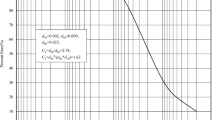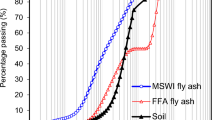In the western regions of China, loess soils are widely used as fill materials in the construction of highways and building foundations. The hydraulic conductivity of this fill material is a significant parameter for initial engineering designs, but currently there are a very limited number of investigations into this aspect. In this study, a series of tests on compacted loess soils was conducted to determine how the dry density and water content affect loess permeability. The test results show that the hydraulic conductivity decreases gradually with the final water content or with increase in the final dry density. The phenomenon is induced by a decrease in cumulative volume or void ratio, which is verified by the results of mercury intrusion porosimetry and scanning electron microscopy images. A new mathematical model is proposed for predicting the value of k in compacted loess soils, expressed as a function of water content and void ratio.
Similar content being viewed by others
References
J. M. Sun, “Provenance of loess material and formation of loess deposits on the Chinese Loess Plateau,” Earth Planet. Sci. Lett., 203, 845-859 (2002).
B. P. Wen and Y. J. Yan, “Influence of structure on shear characteristics of the unsaturated loess in Lanzhou, China,” Eng. Geol., 168, 46-58 (2014).
H. J. Yu, “A new exploration on the origin of loess in the shelf area of the eastern China seas,” Quatern. Sci., 4, 366-372 (1999).
X. M. Fang, J. J. Li, and V. D. V. Rob, “Discussion on the formation age of loess in western Qinling and its relationship with provenance area,” Chin. Sci. Bull., 44(7), 779-782 (1999).
W. M. Ye, Y. J. Cui, and Y. Huang, “Collapsibility of loess and its discrimination criteria,” Chin. J. Rock Mech. Eng., 25(3), 550-556 (2006).
Z. Liu, F. Y. Liu, F. L. Ma, M. Wang, and X. H. Bai, “Collapsibility, composition, and microstructure of loess in China,” Can. Geotech. J., 53, 673-686 (2016).
T. X. Wang, J. Lu, and J. F. Zhang, “Experimental study on permeability coefficient of artificially compacted unsaturated loess considering influence of density,” Chin. J. Rock Mech. Eng., 25(11), 2364-2368 (2018).
W. W. Chen, W. Liu, J. Wang, G. P. Sun, W. J. Wu, and X. Q. Hou, “Prediction of coefficient of permeability of unsaturated loess with different seepage durations,” Chin. J. Geotech. Eng., 40, 22-26 (2018).
Z. Q. Hu, Z. J. Shen, and D. Y. Xie, “Constitutive model of structural loess,” Chin. J. Rock Mech. Eng., 24(4), 565-569 (2005).
F. Chu and S. J. Shao, “Experimental study on constitutive model of structural Q3 loess in Longdong area based on concept of disturbance state,” Chin. J. Rock Mech. Eng., 37(9), 2180-2188 (2018).
AFNOR, “Geotechnical investigating and testing, Laboratory testing of soils, Part 11: Determination of permeability by constant and falling head,” XP CEN ISO/TS 17892-5 (2005).
American Society for Testing and Materials (ASTM), Standard test methods for liquid limit, plastic limit, and plasticity index of soils. Soil and Rock, West Conshohocken, PA, D4318 (2010).
American Society for Testing and Materials (ASTM), Standard test methods for specific gravity of soil solids by water pycnometer. Soil and Rock, West Conshohocken, PA, D4318 (2014) .
American Society for Testing and Materials (ASTM), Standard Test Method for Particle-size Analysis of Soils. Soil and Rock, West Conshohocken, PA, D422-63 (2007).
American Society for Testing and Materials (ASTM), Standard Test Methods for Laboratory Compaction Characteristics of Soil Using Modified Effort. ASTM International, West Conshohocken, PA, D1557-12 (2012).
American Society for Testing and Materials (ASTM), Standard Practice for Classification of Soils for Engineering Purposes. Unified Soil Classification System, PA, D2487(2010).
Y. F. Deng, A. M. Tang, Y. J. Cui, X. P. Nguyen, X. L. Li, and L. Wouters, “Laboratory Hydro-mechanical characterisation of boom clay at Essen and Mol,” Phys. Chem. Earth, 36, 1878-1890 (2011).
D. Penumadu and J. Dean, “Compressibility effect in evaluating the pore-size distribution of kaolin clay using mercury intrusion porosimetry,” Can. Geotech. J., 37(2), 393-405 (2000).
E. W. Washburn, “Note on a method of determining the distribution of pore sizes in a porous material,” Proc. Natl. Acad. Sci. USA, 7(4), 115 (1921).
G. Mesri and R. E. Olson, “Mechanisms controlling the permeability of clays,” Clay. Clay. Miner., 19(3): 151-158 (1971).
A. M. Samarasinghe, Y. H. Huang, and V. P. Drnevich, “Permeability and consolidation of normally consolidated soils,” J. Geotech. Eng., 108(6), 835-850 (1982).
Author information
Authors and Affiliations
Corresponding author
Additional information
Translated from Osnovaniya, Fundamenty i Mekhanika Gruntov, No. 5, p. 16, September-October, 2020.
Rights and permissions
About this article
Cite this article
Guo, Y., Ni, W., Kou, Z. et al. Experimental Study on the Permeability of Compacted Loess. Soil Mech Found Eng 57, 394–400 (2020). https://doi.org/10.1007/s11204-020-09683-y
Published:
Issue Date:
DOI: https://doi.org/10.1007/s11204-020-09683-y




